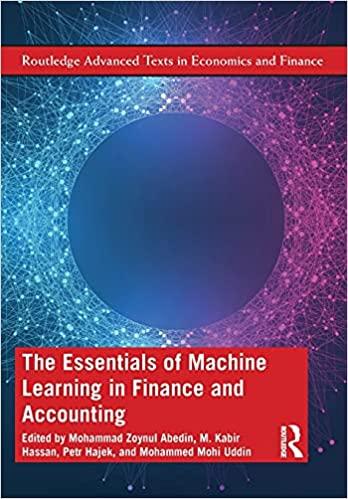
Bertha is considering investing all of her wealth w. She can buy any combination of n assets x~1,,x~n with risky net returns r~i,i=1,,n. That is, putting one dollar into asset i brings back (1+r~i). These returns are identically and independently distributed: that is, the risks are statistically independent, and they have the same cdf F, with identical mean m and identical positive variance s2. We assume that Bertha is risk-averse and her Bernoulli index is u. 1. If Bertha puts fractions 1,,n0 of her wealth into assets 1 to n (with i=1ni=1 ) what will be the mean return of her portfolio? and its variance? 2. Suppose that 1>2. Show that reducing investment in asset 1 by a small >0 and investing in asset 2 instead reduces the variance of the portfolio and does not change its mean. What does this suggest in terms of investment strategy? why does it "suggest" it rather than "prove" it? 3. Conclude from 2. that if the risks are small, Bertha prefers to spread its investments equally: 1==n=1. 4. Use second-order stochastic dominance to prove that the distribution of n1i=1nx~i is less risky than that of any other portfolio. Conclude that diversification is good for Bertha. Bertha is considering investing all of her wealth w. She can buy any combination of n assets x~1,,x~n with risky net returns r~i,i=1,,n. That is, putting one dollar into asset i brings back (1+r~i). These returns are identically and independently distributed: that is, the risks are statistically independent, and they have the same cdf F, with identical mean m and identical positive variance s2. We assume that Bertha is risk-averse and her Bernoulli index is u. 1. If Bertha puts fractions 1,,n0 of her wealth into assets 1 to n (with i=1ni=1 ) what will be the mean return of her portfolio? and its variance? 2. Suppose that 1>2. Show that reducing investment in asset 1 by a small >0 and investing in asset 2 instead reduces the variance of the portfolio and does not change its mean. What does this suggest in terms of investment strategy? why does it "suggest" it rather than "prove" it? 3. Conclude from 2. that if the risks are small, Bertha prefers to spread its investments equally: 1==n=1. 4. Use second-order stochastic dominance to prove that the distribution of n1i=1nx~i is less risky than that of any other portfolio. Conclude that diversification is good for Bertha







